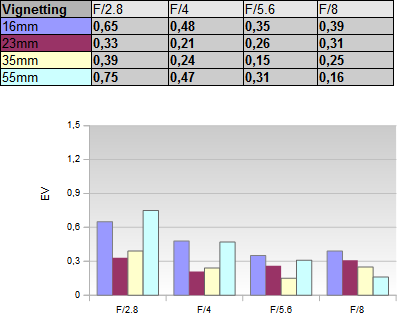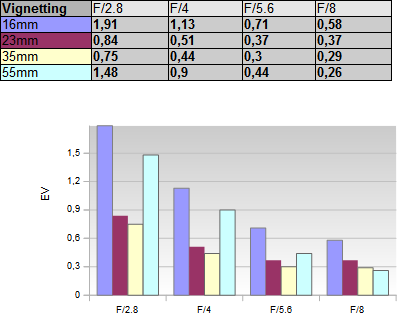|
Fujinon XF 16-55mm f/2.8 R LM WR ( Fujifilm ) Review / Test - Analysis |
|
Lens Reviews -
Fujifilm X
|
|
Page 2 of 3

Distortion
Fujifilm relies on image auto-correction so users don't really need to worry too much about image distortions when keeping all default settings. There's a bit of barrel distortion at wide end but this is about it.
However, it's always interesting to look behind the scene and the situation is not good there. The original characteristic of the lens is disappointing especially given the size of lens and the complexity of the optical design which should really help to tame the issue. At 16mm there is a MASSIVE amount of barrel distortion (5.6%) - the next stop beyond this is a fish-eye lens really. The 2.4% of pincushion distortion at 55mm is also nothing to be proud of either.
If you move your mouse cursor over the image you can switch to the corresponding auto-corrected results (there may be a short delay).
Vignetting
Image auto-correction is also active for vignetting. You may still spot a little light falloff at f/2.8 at the extreme ends of the zoom range but it's not objectionable. Stopping down eliminates the remaining vignetting by real world standards.
 In RAW mode - thus with disabled vignetting- and distortion-correction, we can, unfortunately, observe the dark side of the force again.
The light falloff is clearly visible at f/2.8 with a maximum of 1.8EV (f-stops) at 16mm - this is beyond our usual scale here! 1.5EV at 55mm is also pretty bad actually. Stopping down to f/5.6 is therefore a good idea if you prefer to disable auto-correction altogether.
In RAW mode - thus with disabled vignetting- and distortion-correction, we can, unfortunately, observe the dark side of the force again.
The light falloff is clearly visible at f/2.8 with a maximum of 1.8EV (f-stops) at 16mm - this is beyond our usual scale here! 1.5EV at 55mm is also pretty bad actually. Stopping down to f/5.6 is therefore a good idea if you prefer to disable auto-correction altogether.
 Please note that vignetting compensation is also a lossy procedure because it increases the corner (sensor-)noise due to the required signal amplification.
Please note that vignetting compensation is also a lossy procedure because it increases the corner (sensor-)noise due to the required signal amplification.
MTF (resolution)
The Fujinon XF 16-55mm f/2.8 R LM WR produced decent results in the MTF lab although it stayed short of the high expectations.
The sweet spot is the 16mm setting with an outstanding center quality and a very good outer image region at mainstream aperture settings.
From here on the quality drops gradually towards the tele end. At 55mm f/2.8 the center quality is "merely" very good and the image corners just make it across the "good" mark here. Stopping down helps to lift the quality somewhat. As usual f/11 should be generally avoided due to diffraction effects but it remains a usable setting.
The field curvature is moderate. The centering quality of the tested sample was good albeit not perfect.
Please note that the MTF results reflect the original characteristic of the lens. With activated distortion correction the corners will be somewhat worse at 16mm because of the inevitable image interpolation.
Please note that the MTF results are not directly comparable across the different systems!
Below is a simplified summary of the formal findings. The chart shows line widths
per picture height (LW/PH) which can be taken as a measure for sharpness.
If you want to know more about the MTF50 figures you may check out the corresponding
Imatest Explanations
Chromatic Aberrations (CAs)
Lateral CAs (color shadows at hard contrast transitions) are very well controlled even with disabled image auto-correction. The issue is barely present at 16mm and 23mm but it increases a little at 35mm and 55mm. Even so the maximum stays below an average pixel width of 1.5px at the image borders.

Bokeh
It may be debatable whether the quality of bokeh (rendition of the out-of-focus blur) is a primary aspect of a 16-55mm f/2.8 lens. However, it is certainly possible to produce a decent amount of foreground/background blur when choosing a short focus distance combined with a large aperture setting.
You shouldn't expect wonders from a standard zoom lens but the Fujinon does a comparatively decent job here. The general blur is relatively smooth with a bit of smearing but we've seen a lot worse than that. A good prime lens is better still.
 Out-of-focus highlights show a slightly onion-like substructure - probably related to the aspherical elements. There's also a slight outlining effect. The highlight disc is pretty circular at f/2.8 and f/4. A more edgy aperture shape starts to kick in at f/5.6
Out-of-focus highlights show a slightly onion-like substructure - probably related to the aspherical elements. There's also a slight outlining effect. The highlight disc is pretty circular at f/2.8 and f/4. A more edgy aperture shape starts to kick in at f/5.6

Bokeh Fringing
Bokeh fringing is an axial color fringing effect. It can show up as purple halos in front of the focus point and greenish halos in the background. However, this is usually affecting ultra-large aperture lenses. At f/2.8 it isn't really an issue.
|
Move the mouse cursor over the f-stop marks below to observe the respective LoCAs
|
| f/2.8 |
f/4 |
f/5.6 |
|

|
|